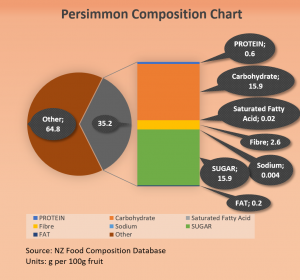PERSIMMON FRUIT.
A persimmon is the edible fruit of a number of species of trees in the genus Diospyros- a number of non-persimmon species of the genus are grown for ebony timber.
The most widely cultivated for fruit, is the Oriental or Japanese persimmon, Diospyros kaki. Diospyros kaki is native to Japan, China, Korea, Burma and Nepal. It is a deciduous tree with with broad, stiff leaves. Cultivation of the fruit extended first to other parts of east Asia, India and Nepal and was later introduced to California and southern Europe in the 1800s and then to other counties including New Zealand.
In New Zealand the most commercially grown persimmons are of the Fuyu variety – a non-astringent variety which means that it can be eaten while it is still crisp.Persimmon fruit matures late in Autumn (April through May in New Zealand), with the export season running through to late July.
In color, a ripe Fuyu fruit is a deep orange colour, but across the cultivated strains colour at fully ripe ranges from glossy light yellow-orange to dark red-orange depending on the species and variety.
Export plantings are widely spread through northern New Zealand. The main areas are Gisborne (about 28% by area), then North and South Auckland (20% each). Other growing regions include Northland, South Auckland, Waikato, Bay of Plenty and the Hawkes Bay.
The ripe fruit has a high glucose content and is sweet in taste. Persimmons are like a tomato, in that while they are not typically considered to be berries, in strict botanical morphology, the fruit is in fact a berry.
NUTRITIONAL INFORMATION
The NZ Food Composition Tables show that 100gm of persimmon contains the following
| Iron | 4mg |
| B-carotene equiv | 1070ug |
| riboflavin | .06mg |
| niacin | .4mg |
| Vitamin B6 | .02mg |
| Vitamin B | 12 ug |
| Folate | 8ug |
| Vitamin C | 10mg |
| Vitamin A equiv | 178mg |
(mg = milligrams, ug = micrograms)
High in vitamin C, persimmons have been recommended for a wide range of reasons, from hypertension to hangovers.
LOOKING AFTER YOUR PERSIMMONS
In the home, persimmons are unlike many fruit, as they keep longer if they are at room temperature. Room temperature is in the range of 15°C to 25°C. In warmer climates therefore, rooms with air conditioning are ideal to keep your persimmons in top condition.
Persimmons kept in a fridge will go soft more quickly than if left at room temperature.
In shops or coolstores the same applies. However when persimmons are exported by sea the tray of fruit is packed in modified atmosphere bags and needs to be stored at 0°C while still in the sealed bags. Bagged persimmons should always be kept in a coolstore. The bags should be cut or removed when they are taken from the coolstore and the persimmons should not be put back into the coolstore once the bag is opened.

